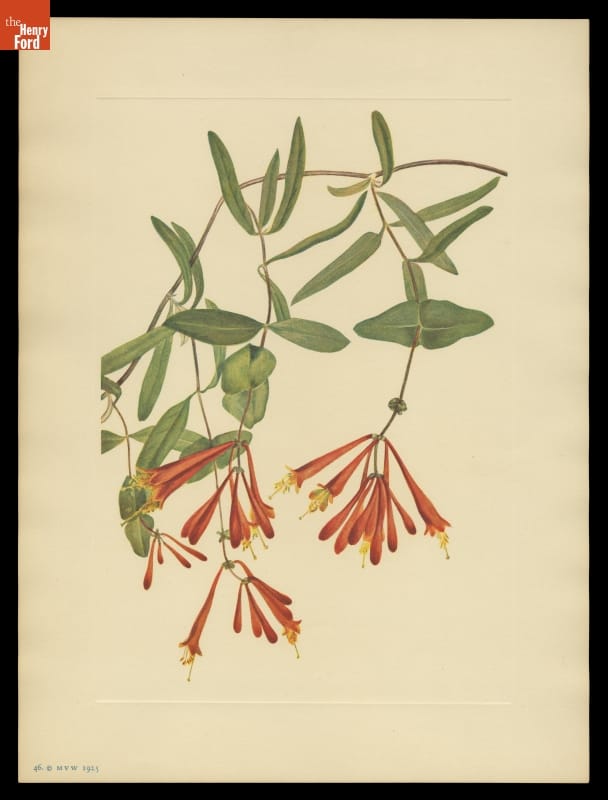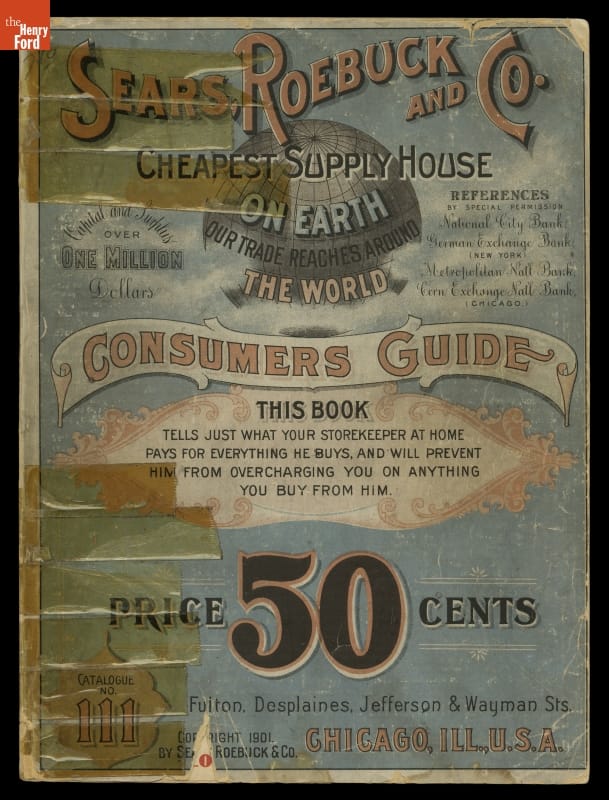Celebrating Ninety: Collecting in the 1950s

Henry Ford’s energy had been the animating force behind the Edison Institute. His death in 1947 challenged the institution to manage a collection that had grown to massive proportions – with no adequate storage solutions and no formal cataloging system.
Aerial View of Henry Ford Museum, circa 1953. THF112188
Clara Ford took over for her husband after his death, and the skeletal staff maintained the status quo at the Institute for the next few years without real direction. In 1950, the death of Clara signaled the end of another era. The Ford family stepped away from the daily management of the institution and began a strong tradition of lay leadership. In the early 1950s, all three of the Fords’ grandsons served on the Board of Trustees. William Clay Ford took over the position of board president in 1951 and remained chairman of the board for 38 years. Museum Executives and "Today" Show Staff after Live Broadcast from Greenfield Village, October 25, 1955. THF116184
Museum Executives and "Today" Show Staff after Live Broadcast from Greenfield Village, October 25, 1955. THF116184
In January 1951, the board appointed A.K. Mills to the new post of executive director of Greenfield Village and the Edison Institute Museum. He implemented business practices and hired professional staff members. During the 1950s, the public – especially the vast traveling public – became the focus of the institution’s attention. In 1952, as a tribute to its founder, the Edison Institute was renamed Henry Ford Museum and Greenfield Village. Mills died suddenly in 1954; Donald Shelley replaced him as executive director, a position he held for the next 22 years. Industrial Progress U.S.A. Exhibit, Henry Ford Museum, 1952-1954. THF112172
Industrial Progress U.S.A. Exhibit, Henry Ford Museum, 1952-1954. THF112172
Traveling exhibits, developed by the institution in the 1950s, offered the museum a chance to promote itself beyond the local area, increase awareness, and increase visitation. Henry Ford Museum’s attendance steadily climbed each year. The number of visitors doubled over the decade, from 500,000 in 1950, to 1 million by 1960. The village and museum had become a national attraction.
Acquisitions to the Collections: 1950s

Walking Doll
In the 1950s, the museum’s curators acquired many objects for the collection through a network of antique collectors and dealers. Curators were especially looking for folk art and other “early American” objects. Collector Titus Geesey of Wilmington, Delaware had filled his home with three decades worth of collecting. Ready to pare down a bit, Geesey sold over 300 objects to the museum over the years, including prints, tableware, coverlets, a weathervane, and toys. This late 19th-century mechanical doll from Geesey’s collection came in 1958. - Jeanine Head Miller, Curator of Domestic Life

Moravian Bowl with Stylized Fish and Turtles in Center, 1810-1820
In the mid-20th century, Henry Ford Museum built on its early holdings to become one of the preeminent collections of American decorative and folk arts. This ceramic serving bowl was made by Moravian-German immigrants in Alamance County, North Carolina. The playfully arranged turtles and fish are unique representations in Moravian ceramics, which usually emphasizes abstract decoration. - Charles Sable, Curator of Decorative Arts

1941 Allegheny Steam Locomotive
It's perhaps the most photographed object in Henry Ford Museum of American Innovation, and certainly among the best-remembered by our visitors. The mighty Allegheny has anchored the museum's railroad collection since 1956. Used steam locomotives were a dime a dozen in those days as railroads switched to diesel-electric power. Some went to museums and some to tourist railroads. But many more went to city parks and county fairgrounds, left to the mercies of the weather. The Allegheny is a gem carefully preserved indoors for more than 60 years now -- four times longer than it actually operated on the Chesapeake & Ohio Railway. - Matt Anderson, Curator of Transportation

"Battle Scenes of the Rebellion" Battle of Gettysburg, Civil War Panorama"
In the 1880s, Thomas Clarkson Gordon (1841-1922), a self-taught artist and Civil War veteran, created a panorama depicting scenes from the Civil War. Gordon toured his 15-paneled panorama throughout eastern Indiana, retelling the history of the conflict through his vivid illustrations. In 1956, Thomas Gordon's daughters wrote to Henry Ford II, hoping he would want the panorama for his grandfather's "Dearborn Museum." The request was redirected to the Henry Ford Museum and Greenfield Village. The donation arrived in 1958. - Andy Stupperich, Associate Curator, Digital Content

Birth and Baptismal Certificate for Maria Heimbach, 1784|
German immigrants in Pennsylvania created fraktur – highly-decorated documents – to commemorate life’s most significant events. This particular fraktur is a Geburts-und Taufscheine – or a birth and baptismal certificate – and is the most common type. The name fraktur is rooted in a German calligraphic tradition and was primarily used for official documents. The Pennsylvania German frakturs continue this typographic tradition but expand upon it to create a new cultural tradition for a new homeland. - Katherine White, Associate Curator

1953 Ford X-100 Concept Car
During its 50th anniversary in 1953, Ford Motor Company celebrated the past and looked to the future. A. K. Mills -- former head of Public and Employee Relations and recently-appointed Executive Director of the newly-renamed Henry Ford Museum -- managed multiple anniversary projects. While Mills organized new exhibits, oral histories, books, films, and -- most importantly -- a company archive, Ford engineers completed a special project of their own. Their fully-functional concept car, known as the X-100, was showcased during anniversary celebrations and featured more than 50 futuristic innovations, including heated seats and a telephone. - Ryan Jelso, Associate Curator

Print of Mary Vaux Walcott Wildflower Sketch, "Trumpet Honeysuckle," 1925
Clara Ford was an active gardener who presided over several gardening organizations during her lifetime. Citing her interest in flowers, the William Edwin Rudge Printing House of New York sent Mrs. Ford a set of prints originally illustrated by Mary Vaux Walcott in 1925. (The gift also served to demonstrate the quality of the firm’s color reproductions.) When Clara Ford died in 1950, a group of items from her estate – including these prints – came into the museum’s collection. - Saige Jedele, Associate Curator, Digital Content

Sears, Roebuck and Company Mail-Order Catalog, "Consumers Guide, 1901," Catalogue No. 111
Mail order catalogs opened up the world of retail to families around the country. With thousands of items right at their fingertips this Sears and Roebuck catalog would give access to clothing, equipment, home goods, and everything in between to anyone in the United States. The Benson Ford Research Center now utilizes trade catalogs like this to document fashion and innovation of the time. - Sarah Andrus, Librarian

H.J. Heinz Company Collection
Expansion at the H.J. Heinz Company in Pittsburgh during the early 1950s looked to be the end for “The Little House Where We Began,” the small brick building where H.J. Heinz began his business and that had been moved by barge to Pittsburgh in 1904. To save it from demolition, the H.J. Heinz Company donated the building to the Edison Institute, where it was reconstructed in Greenfield Village as the Heinz House. Along with the building, the H.J. Heinz Company donated this sizable archival collection that includes photographs, advertising layouts, publications, scrapbooks, and business records, all of which help convey the history of the Heinz House, the H.J. Heinz Company, and other stories of innovation and entrepreneurship. - Brian Wilson, Senior Manager, Archives and Library

Ford-Ferguson Model 9N Tractor, 1940
The Ford Motor Company re-entered the tractor business in the United States in 1939 with the 9N, a Ford tractor with a 3-point hydraulic hitch-and-lift system invented by Harry Ferguson. After Edsel and Henry both died, Henry Ford II ended the Ford-Ferguson arrangement and released a new model, the 8N, marketed through the Dearborn Motor Corporation, not through Ferguson. Ferguson sued, and after four years he accepted $9.25 million paid by FMC to settle the patent-infringement case. This tractor was one of eight that FMC assembled for the litigation and then transferred to the Edison Institute to complete its display of Ford tractors. - Debra Reid, Curator of Agriculture and the Environment
Henry Ford Museum, #Behind The Scenes @ The Henry Ford, THF90


Facebook Comments